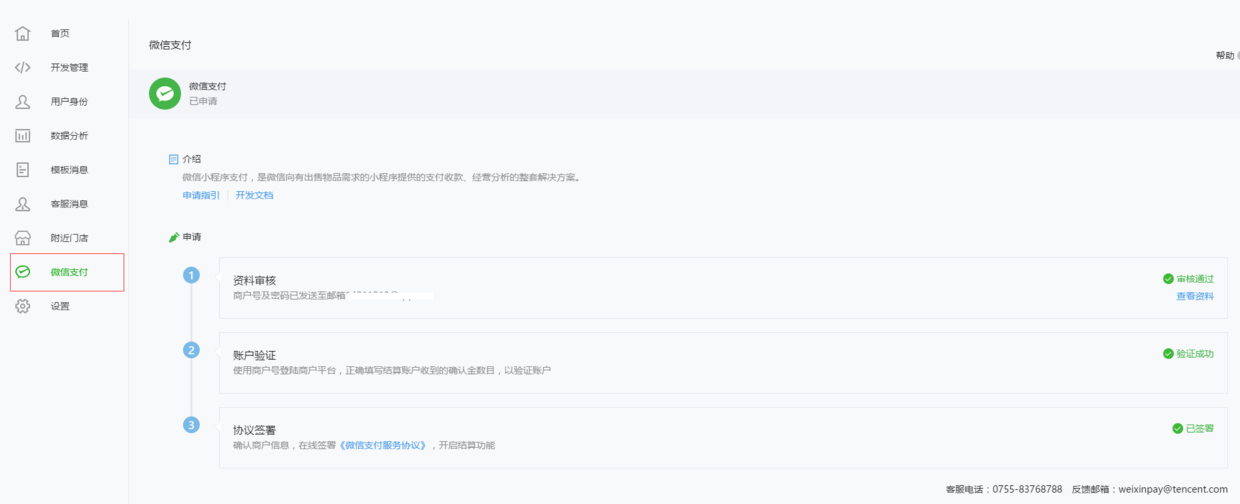Home > Article > WeChat Applet > Implementation code for online payment function developed by WeChat applet
This article mainly introduces the relevant information on the implementation code of the online payment function developed by WeChat mini program. Friends in need can refer to the following
Online payment function of WeChat mini program
Recently I needed to use the online payment function in the WeChat mini program, so I took a look at the official documents and found that it is very convenient to implement WeChat payment in the mini program. If you have developed WeChat payment under a service account before, then You will find that the development process of WeChat payment in the mini program is exactly the same as that in the service account. Now I will talk about the development process and points of attention of WeChat payment in the mini program in detail.

1. Open WeChat payment and WeChat merchant account
This process is the same as the WeChat payment process of opening a service account Same, nothing to say.

2. Obtain the user’s openid
We need to do this on the client side of the mini program## Get the current user's openid in #js. You can get the user's code by calling the wx.login method, and then the developer server uses the login credential code to obtain the openid.
wx.login({
success: function(res) {
if (res.code) {
//发起网络请求
wx.request({
url: 'https://yourwebsit/onLogin',
method: 'POST',
data: {
code: res.code
},
success: function(res) {
var openid = res.data.openid;
},
fail: function(err) {
console.log(err)
}
})
} else {
console.log('获取用户登录态失败!' + res.errMsg)
}
}
});
var code = req.param("code");
request({
url: "https://api.weixin.qq.com/sns/jscode2session?appid="+appid+"&secret="+secret+"&js_code="+code+"&grant_type=authorization_code",
method: 'GET'
}, function(err, response, body) {
if (!err && response.statusCode == 200) {
res.json(JSON.parse(body));
}
});
3. Get prepay_id and payment signature verification paySign
function jsApiCall()
{
WeixinJSBridge.invoke(
'getBrandWCPayRequest',
{
"appId":"", //公众号名称,由商户传入
"timeStamp":"", //时间戳,自1970年以来的秒数
"nonceStr":"", //随机串
"package":"prepay_id=<%=prepay_id%>",
"signType":"MD5", //微信签名方式:
"paySign":"<%=_paySignjs%>" //微信签名
},
function(res){
WeixinJSBridge.log(res.err_msg);
if( res.err_msg =="get_brand_wcpay_request:ok"){
alert("支付成功!");
}else{
alert("支付失败!");
}
}
);
} In the mini program, we activate the payment function through the wx.requestPayment method. Of course, here Before, we first need to get the prepay_id.
wx.request({
url: 'https://yourwebsit/service/getPay',
method: 'POST',
data: {
bookingNo:bookingNo, /*订单号*/
total_fee:total_fee, /*订单金额*/
openid:openid
},
header: {
'content-type': 'application/json'
},
success: function(res) {
wx.requestPayment({
'timeStamp':timeStamp,
'nonceStr': nonceStr,
'package': 'prepay_id='+res.data.prepay_id,
'signType': 'MD5',
'paySign': res.data._paySignjs,
'success':function(res){
console.log(res);
},
'fail':function(res){
console.log('fail:'+JSON.stringify(res));
}
})
},
fail: function(err) {
console.log(err)
}
})The main thing to achieve on the server side is to obtain prepay_id and sign paySign
var bookingNo = req.param("bookingNo");
var total_fee = req.param("total_fee");
var openid = req.param("openid");
var body = "费用说明";
var url = "https://api.mch.weixin.qq.com/pay/unifiedorder";
var formData = "";
formData += "appid "; //appid
formData += "test ";
formData += "" + body + "";
formData += "mch_id "; //商户号
formData += "nonce_str ";
formData += "notify_url ";
formData += "" + openid + " ";
formData += "" + bookingNo + " ";
formData += "spbill_create_ip ";
formData += "" + total_fee + " ";
formData += "JSAPI ";
formData += "" + paysignjsapi(appid, attach, body, mch_id, nonce_str, notify_url, openid, bookingNo, spbill_create_ip, total_fee, 'JSAPI') + " ";
formData += " ";
request({
url: url,
method: 'POST',
body: formData
}, function(err, response, body) {
if(!err && response.statusCode == 200) {
var prepay_id = getXMLNodeValue('prepay_id', body.toString("utf-8"));
var tmp = prepay_id.split('[');
var tmp1 = tmp[2].split(']');
//签名
var _paySignjs = paysignjs(appid, mch_id, 'prepay_id=' + tmp1[0], 'MD5',timeStamp);
var o = {
prepay_id: tmp1[0],
_paySignjs: _paySignjs
}
res.send(o);
}
});The following is used The
function paysignjs(appid, nonceStr, package, signType, timeStamp) {
var ret = {
appId: appid,
nonceStr: nonceStr,
package: package,
signType: signType,
timeStamp: timeStamp
};
var string = raw1(ret);
string = string + '&key='+key;
console.log(string);
var crypto = require('crypto');
return crypto.createHash('md5').update(string, 'utf8').digest('hex');
};
function raw1(args) {
var keys = Object.keys(args);
keys = keys.sort()
var newArgs = {};
keys.forEach(function(key) {
newArgs[key] = args[key];
});
var string = '';
for(var k in newArgs) {
string += '&' + k + '=' + newArgs[k];
}
string = string.substr(1);
return string;
};
function paysignjsapi(appid, attach, body, mch_id, nonce_str, notify_url, openid, out_trade_no, spbill_create_ip, total_fee, trade_type) {
var ret = {
appid: appid,
attach: attach,
body: body,
mch_id: mch_id,
nonce_str: nonce_str,
notify_url: notify_url,
openid: openid,
out_trade_no: out_trade_no,
spbill_create_ip: spbill_create_ip,
total_fee: total_fee,
trade_type: trade_type
};
var string = raw(ret);
string = string + '&key='+key;
var crypto = require('crypto');
return crypto.createHash('md5').update(string, 'utf8').digest('hex');
};
function raw(args) {
var keys = Object.keys(args);
keys = keys.sort()
var newArgs = {};
keys.forEach(function(key) {
newArgs[key.toLowerCase()] = args[key];
});
var string = '';
for(var k in newArgs) {
string += '&' + k + '=' + newArgs[k];
}
string = string.substr(1);
return string;
};
function getXMLNodeValue(node_name, xml) {
var tmp = xml.split("<" + node_name + ">");
var _tmp = tmp[1].split("");
return _tmp[0];
}In just 3 simple steps, the WeChat payment function of the mini program is connected. The following is the test payment effect diagram


The above is the detailed content of Implementation code for online payment function developed by WeChat applet. For more information, please follow other related articles on the PHP Chinese website!